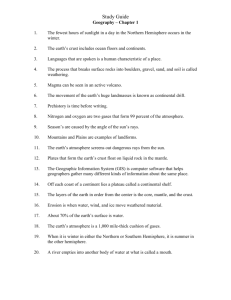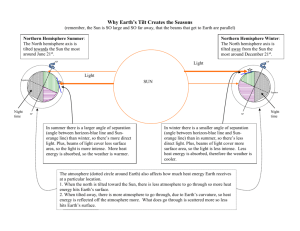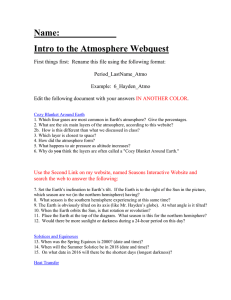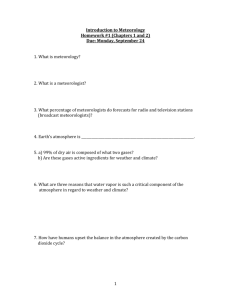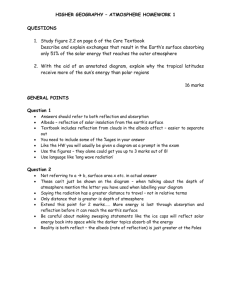Atmosphere - Cloudfront.net
advertisement
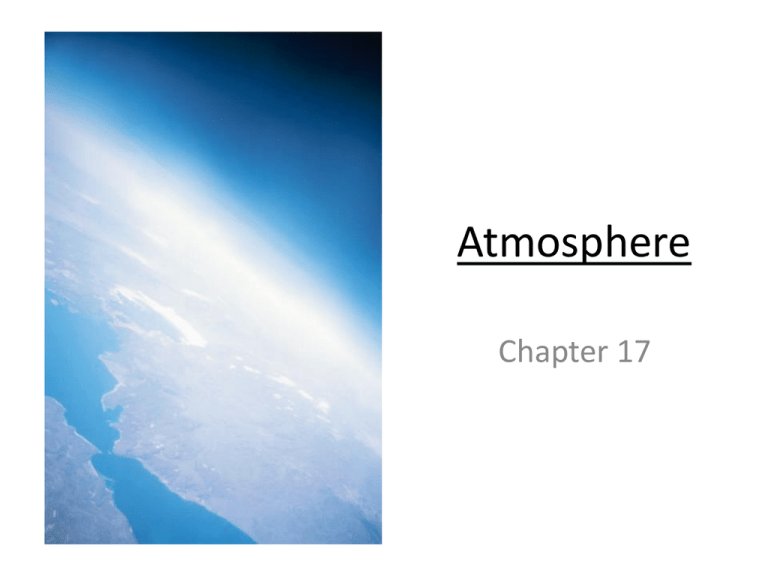
Atmosphere Chapter 17 17.1 Atmospheric Characteristics Atmosphere: the gaseous layer that surrounds the Earth I. In the past, gases came from volcanic eruptions A. Water vapor was a major component of “outgassing” B. Other gases included carbon dioxide, hydrogen, sulfur dioxide, and diatomic nitrogen II. Composition of Atmosphere A. Earth’s lower atmosphere is a mixture of many different gases we call air. B. Air is made of 4 main gases 1. 78.08% Nitrogen (N) 2. 20.95% Oxygen (O2) 3. 0.934% Argon (Ar) 4. 0.036% Carbon Dioxide (C02) C. Air contains particulate matter 1. Dust and earth 2. Chemicals 3. Pollen 4. Soot D. Air is the same worldwide, with local variation (ex: H20 vapor) III. The Structure of the Atmosphere A. Temperature changes greatly at different altitudes (heights) B. The atmosphere is divide into layers based on temperature differences, like the layers of the ocean. How many layers do you see here? IV. Atmospheric Layers A. Troposphere 1. The lowest layer, the one we live in. 2. 0 to 15km above Earth 3. Contains 80% of the atmosphere’s mass 4. Most water vapor and weather are located here 5. Stops at tropopause 6. Jetstream is located just below tropopause (where most planes fly) 7. Temperature decreases with altitude B. Stratosphere 1. The second layer 2. 15 to 50 km high 3. Dry (no water vapor) 4. Stable (no weather) 5. Ozone layer is located near the top a. form of oxygen gas (O3 instead of O2) b. protects us from Sun’s UV rays c. absorbs UV rays and releases them as heat 6. Temperature increases with altitude in the stratosphere 7. Stops at stratopause C. Mesosphere 1. the third layer 2. 50 to 90 km 3. Temperature decreases with altitude as you move away from the ozone layer 4. Stops at mesopause D. Thermosphere 1. 4th layer 2. Located above the mesopause 3. 90 km and higher above the Earth 4. The least dense layer of the atmosphere. 5. Composed of layers of N2, O2, He, and finally H that thins out into space. 6. Temperature increases with altitude because of the intense solar radiation 7. Also called the ionosphere because the air is highly ionized. 8. Aurora Borealis (The Northern Lights) occur here. Thermal structure of the atmosphere V. Earth – Sun Relationships A. Rotation: 1. the spinning of Earth around its axis 2. Earth completes 1 rotation every 24 hrs. 3. results in day and night 4. fastest at equator, slowest at poles At the equator, 1 rotation equals 40,074 km per 24 hours (1690 km/hr). Near the poles, 1 rotation equals nearly 0 km per 24 hours (0 km/hr), because the poles are nearest to the axis! B. Earth’s axis 1. Imaginary rod running through the Earth from the north pole to the south pole. 2. Earth rotates around this rod counterclockwise 3. The axis is tilted 23.5° 4. Points straight towards Polaris, the North Star! (This is why Polaris appears at the same place in the sky every single night of the year!) C. Earth’s Revolution 1. Revolution: one complete orbit of Earth around the sun 2. 365.24 days, or 1 year Remember, the Earth is tilted 23.5° on its axis. So, depending on where the Earth is in its orbit, 1 hemisphere is always tilted toward the sun, as the other is tilted away. D. The Seasons 1. When northern hemisphere is tilted toward the sun Summer a. more direct sunlight b. warmer temps c. longer days d. Summer Solstice: i. longest day of the year ii. June 21-22 iii. sun is directly over the Tropic of Cancer 2. When northern hemisphere is tilted away from the sun Winter a. least direct sunlight b. colder temps c. shorter days d. Winter Solstice: i. shortest day of the year ii. December 21-22 iii. sun is directly over the Tropic of Capricorn 3. Equinox: a. day and night are equal all over the world b. 2 days out of the year c. ½ way between the solstices d. neither hemisphere tilts toward the sun e. Sun is directly over the Equator f. Vernal Equinox: March 21-22; beginning of spring in the northern hemisphere g. Autumnal Equinox: Sept. 22-23; beginning of fall in the northern hemisphere page 482, Figure 8 – Solstices and Equinoxes 17.2 Heat and the Atmosphere I. Heat Energy A. Radiation: the transfer of heat energy in the form of light 1. In the form of electromagnetic waves 2. Visible light, UV rays, infrared, etc. 3. This is how heat energy from the sun reaches Earth B. Conduction: 1. The transfer of heat energy through touching Ex: Touching a hot pan; walking barefoot on hot sand 2. Occurs through the collisions of atoms or molecules C. Convection: 1. The transfer of heat energy in a gas or liquid because of density difference 2. Hot things are less dense than cold things Ex: The air above a fire is heated, rises, and then heats the air above it What type of transfer? Coffee warming a cup? Conduction Steam rising from coffee? Convection Pan warmed on stove? Conduction Fire warming your face? Radiation II. Heat and temperature A. Temperature measures how fast the molecules of a substance are moving. B. Boiling water has more movement than cold water and a higher temperature C. Heat measures the total energy contained in the particles in a substance. 1. A large cup of coffee has more heat energy than a small cup of coffee 2. Heat moves from high to low temperature III. Insolation and the Atmosphere A. Insolation: incoming solar radiation B. Earth’s atmosphere receives only about 1/twobillionth of the sun’s rays C. Global Heat Budget: shows the overall flow of energy into and out of the system. (Fig 12) 1. 30% reflected back out to space 2. 20% absorbed by gases (CO2 and H2O) in the atmosphere 3. 50% is absorbed by Earth’s surface or used during photosynthesis (eventually radiated back into space as heat) Solar Radiation (page 486, Fig 12) D. Greenhouse Effect 1. Greenhouse gases (CO2, H20, CH4) absorb and re-radiate heat into atmosphere 2. Helps to keep Earth at a livable temp. E. Global Warming 1. An increase in the average global temperature due to rising levels of carbon dioxide in the atmosphere. 2. Main causes: burning of fossil fuels and deforestation 3. Effects: a. rising sea levels due to melting polar ice b. unstable weather conditions c. frequent heat waves and droughts d. relocation of crop lands 17.3 Local Temperature Variations Key Concept : Insolation heats the Earth’s surface unequally. I. Time of Day A. Warmest time = Afternoon 1. Earth absorbs most heat at noon 2. Earth re-radiates heat after noon B. Coldest time = just after sunrise 1. Ground and atmosphere lose heat all night 2. Additional heat is lost from evaporation of water at sunrise II. Latitude A. Warmest parts of Earth = near the equator • The sun’s rays are most directly overhead all year long. B. Coldest parts of Earth = near the poles • The sun’s rays are least directly overhead. Relationship of sun angle and solar radiation received on Earth III. Time of Year A. Warmest season = summer 1. Sun directly overhead all season 2. Days are longer B. Coldest season = winter 1. Sun is further away and not directly overhead 2. Days are shorter Relationship of sun angle to the path of solar radiation and seasons due to Earth’s tilt IV. Cloud Cover A. More clouds = colder days and warmer nights 1. Reflects insolation to space during day 2. Traps heat from Earth during night B. Less clouds = warmer days and colder nights 1. Allows insolation to reach Earth 2. Allows Earth’s radiation to escape to space C. Clouds reduce the daily temperature range (max high to max low) V. Type of Material A. Water and land don’t heat the same 1. Water heats more slowly than land 2. Water cools more slowly than land B. Color and texture also affect absorption 1. Dark colors warm faster than light colors 2. Rough textures warm faster than smooth VI. Temperature Inversion… A. occurs when surface air is cooler than the upper air. B. Prevents convection, no circulation occurs. C. Traps pollutants near surface. VII. World Distribution of Temperature A. Map shows the effects of latitude on incoming solar radiation. B. Isotherms – lines that connect points of same temperature C. Shows East to West lateral banding D. Trend is decreasing temperatures from equator to poles E. All measurements are for sea level.
